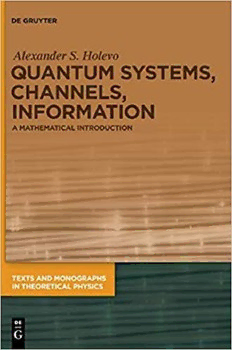Table Of ContentAlexanderS.Holevo
QuantumSystems,Channels,Information
Brought to you by | provisional account
Unauthenticated
Download Date | 1/12/20 9:11 AM
Texts and Monographs in
Theoretical Physics
|
Edited by
Michael Efroimsky, Bethesda, Maryland, USA
Leonard Gamberg, Reading, Pennsylvania, USA
Brought to you by | provisional account
Unauthenticated
Download Date | 1/12/20 9:11 AM
Alexander S. Holevo
Quantum Systems,
Channels,
Information
|
A Mathematical Introduction
2nd edition
Brought to you by | provisional account
Unauthenticated
Download Date | 1/12/20 9:11 AM
PhysicsandAstronomyClassification2010
03.67.-a,05.30.-d,02.30.Tb,02.50.-r
Author
Prof.Dr.AlexanderS.Holevo
RussianAcademyofSciences
SteklovMathematicalInstitute
DepartmentofProbabilityTheoryand
MathematicalStatistics
Gubkinastr.8
Moscow119991
Russia
[email protected]
ISBN978-3-11-064224-7
e-ISBN(PDF)978-3-11-064249-0
e-ISBN(EPUB)978-3-11-064240-7
ISSN2627-3934
LibraryofCongressControlNumber:2019938956
BibliographicinformationpublishedbytheDeutscheNationalbibliothek
TheDeutscheNationalbibliothekliststhispublicationintheDeutscheNationalbibliografie;
detailedbibliographicdataareavailableontheInternetathttp://dnb.dnb.de.
©2019WalterdeGruyterGmbH,Berlin/Boston
Coverimage:Curtis,Kevin/SciencePhotoLibrary
Typesetting:VTeXUAB,Lithuania
Printingandbinding:CPIbooksGmbH,Leck
www.degruyter.com
Brought to you by | provisional account
Unauthenticated
Download Date | 1/12/20 9:11 AM
Preface
Quantuminformationtheorystudiesthegenerallawsoftransfer,storage,andpro-
cessing of information in systems obeying the laws of quantum mechanics. It took
shapeasaself-consistentareaofresearchinthe1990s,whileitsorigincanbetraced
backtothe1950–1960s,whichwaswhenthebasicideasofreliabledatatransmission
andofShannon’sinformationtheoryweredeveloped.Atthefirststage,whichcov-
erstheperiod1960–1980,themainissueconsistedofthefundamentalrestrictionson
thepossibilitiesofinformationtransferandprocessingcausedbythequantumme-
chanicalnatureofitscarrier.Moderntechnologicaldevelopments,relyinguponthe
achievementsofquantumelectronicsandquantumoptics,suggestthatintheforesee-
ablefuturesuchrestrictionswillbecomethemainobstaclelimitingfurtherextrapo-
lationofexistingtechnologiesandprinciplesofinformationprocessing.
Theemergence,inthe1980–1990s,oftheideasofquantumcomputing,quantum
cryptography,andthenewcommunicationprotocols,ontheotherhand,alloweddis-
cussingnotonlytherestrictions,butalsothenewpossibilitiescreatedbytheuseof
specificquantumresources,suchasquantumentanglement,quantumcomplemen-
tarity,andquantumparallelism.Quantuminformationtheoryprovidesthecluetoun-
derstandingthesefundamentalissuesandstimulatesthedevelopmentofexperimen-
talphysics,withpotentialimportancetonew,effectiveapplications.Atpresent,inves-
tigationsintheareaofquantuminformationscience,includinginformationtheory,its
experimentalaspects,andtechnologicaldevelopments,areongoinginadvancedre-
searchcentersthroughouttheworld.
The mathematical toolbox of “classical” information theory contains methods
basedonprobabilitytheory,combinatorics,andmodernalgebra,includingalgebraic
geometry. For a mathematician sensible to the impact of his research on the natu-
ralsciences,informationtheorycanbeasourceofdeepideasandnew,challenging
problems, with sound motivation and applications. This equally, if not to a greater
extent, applies to quantum information theory, the scope of which turns out to be
closely connected to multilinear algebra and noncommutative analysis, convexity,
andasymptotictheoryoffinite-dimensionalnormedspaces,subtleaspectsofposi-
tivityandtensorproductsinoperatoralgebras,andthemethodsofrandommatrices.
Nowadays,theintimateconnectionstooperatorspacesandso-called“quantumfunc-
tionalanalysis”havebeenrevealedandexplored.
In2002,theMoscowIndependentUniversitypublishedtheauthor’slecturenotes
(inRussian),inwhichanattemptwasmadeatamathematician’sintroductiontoprob-
lemsofquantuminformationtheory.In2010,asubstantiallyexpandedtextwaspub-
lishedwiththetitle“Quantumsystems,channels,information.”Theauthor’sinten-
tionwastoprovideawidelyaccessibleandself-containedintroductiontothesubject,
startingfromprimarystructuresandleadinguptonontrivialresultswithratherde-
https://doi.org/10.1515/9783110642490-201
Brought to you by | provisional account
Unauthenticated
Download Date | 1/12/20 9:11 AM
VI | Preface
tailedproofs,aswellastosomeopenproblems.ThepresentEnglishtextisafurther
stepinthatdirection,extendingandimprovingtheRussianversionof2010.
The exposition is organized in concentric circles, the Nth round consisting of
PartsItoN,whereeachcircleisself-contained.Thereadercanrestricthimselftoany
ofthesecircles,dependingonthedepthofpresentationthatheorshedemands.In
particular,inPartItoPartIV,weconsiderfinite-dimensionalsystemsandchannels,
whereastheinfinite-dimensionalcaseistreatedinthefinalPartV.
PartIstartswithadescriptionofthestatisticalstructureofquantumtheory.After
introducingthenecessarymathematicalprerequisitesinChapter1,thecentralfocus
inChapters2,3isondiscussingthekeyfeaturesofquantumcomplementarity and
entanglement.Theformerisreflectedbythenoncommutativityofthealgebraofob-
servablesofthesystem,whilethelatterisreflectedbythetensorproductstructure
ofcompositequantumsystems.Chapter3alsocontainsthefirstapplicationsofthe
information-theoreticapproachtoquantumsystems.
Ininformationtheory,thenotionsofachannelanditscapacity,givingameasure
ofultimateinformation-processingperformanceofthechannel,playacentralrole.In
Chapter4ofPartII,areviewofthebasicconceptsandnecessaryresultsfromclassical
informationtheoryisprovided,thequantumanalogsofwhicharethemainsubjectof
thefollowingchapters.Theconceptsofrandomcodingandtypicalityareintroduced
andthenextendedtothequantumcaseinChapter5.Thatchaptercontainsdirectand
self-consistentproofsofthequantuminformationboundandoftheprimarycoding
theoremsfortheclassical-quantumchannels,whichwilllaterserveasabasisforthe
moreadvancedcapacityresultsinChapter8.
PartIIIisdevotedtothestudyofquantumchannelsandtheirentropycharacteris-
tics.InChapter6,wediscussthegeneralconceptandstructureofaquantumchannel,
withthehelpofavarietyofexamples.Fromthepointofviewofoperatoralgebras,
thesearenormalizedcompletelypositivemaps,theanalogofMarkovmapsinnon-
commutativeprobabilitytheory,andtheyplaytheroleofmorphismsinthecategory
ofquantumsystems.Fromthepointofviewofstatisticalmechanics,achannelgives
anoveralldescriptionoftheevolutionofanopenquantumsysteminteractingwith
anenvironment–aphysicalcounterpartofthemathematicaldilationtheorem.Vari-
ousentropicquantitiesessentialtothecharacterizationoftheinformation-processing
performance,aswellastheirreversibilityofthechannel,areinvestigatedinChapter7.
PartIVisdevotedtotheproofsofadvancedcodingtheorems,whichgivethemain
capacitiesofaquantumchannel.Remarkably,inthequantumcase,thenotionofthe
channelcapacitysplits,givingawholespectrumofinformation-processingcharac-
teristics,dependingonthekindofdatatransmitted(classicalorquantum),aswell
asontheadditionalcommunicationresources.InChapter8,wediscusstheclassical
capacityofaquantumchannel,i.e.,thecapacityfortransmittingclassicaldata.We
touchuponthetremendousprogressmaderecentlyinthesolutionoftherelatedaddi-
tivityproblemandpointouttheremainingquestions.Chapter9isdevotedtotheclas-
sicalentanglement-assistedcapacityanditscomparisonwithunassistedcapacity.In
Brought to you by | provisional account
Unauthenticated
Download Date | 1/12/20 9:11 AM
Preface | VII
Chapter10,weconsiderreliabletransmissionofquantuminformation(i.e.,quantum
states),whichturnsouttobecloselyrelatedtotheprivatetransmissionofclassical
information.Thecorrespondingcodingtheoremsprovidethequantumcapacityand
theprivateclassicalcapacityofaquantumchannel.
InPartV,wepassfromfinite-dimensionaltoseparableHilbertspace.Chapter11
dealswiththenewobstaclescharacteristicforinfinite-dimensionalchannels–singu-
larbehavioroftheentropy(infinitevalues,discontinuity)andtheemergenceofthe
inputchannelconstraints(e.g.,finitenessofthesignalenergy)andofthecontinuous
optimizingstateensembles.Chapter12treatsthebosonicGaussiansystemsandchan-
nelsonthecanonicalcommutationrelations(manyexperimentaldemonstrationsof
quantum information processing were realized in such “continuous-variables” sys-
tems,basedinparticularontheprinciplesofquantumoptics).Weassumethereader
hassomeminorbackgroundinthefieldandstartwitharatherextendedintroduc-
tionatthebeginningofChapter12.Next,wedescribeandstudyindetailtheGaus-
sianstatesandchannels.Themainmathematicalproblemsherearethestructureof
themultimodequantumGaussianchannelsandthecomputationofthevariousen-
tropicquantitiescharacterizingtheirperformance.Whiletheclassicalentanglement-
assisted capacity is, in principle, computable for a general Gaussian channel, the
quantumcapacityisfoundonlyforrestrictedclassesofchannels,andtheunassisted
classical capacity in general presents an open analytical problem, namely, that of
verifyingtheconjectureof“quantumGaussianoptimizers,”whichiscomparablein
complexitytotheadditivityproblem(alsoopenfortheclassofGaussianchannels)
andappearstobecloselyrelatedtoit.
Thisbookdoesnotintendtobeanall-embracingtextinquantuminformation
theoryanditscontentdefinitelyreflectstheauthor’spersonalresearchinterestsand
preferences. For example, the important topics of entanglement quantification and
errorcorrectionarementionedonlybriefly.Aninterestedreadercanfindanaccount
oftheseinothersources,listedinthenotesandreferencestotheindividualchapters.
Quantum information theory is in a stage of fast development and new, important
resultscontinuetoappear.Yet,wehopethepresenttextwillbeausefuladditiontothe
existingliterature,particularlyformathematicallyinclinedreaderseagertopenetrate
thefascinatingworldofquantuminformation.
ThebasisfortheselecturenoteswasacoursetaughtbytheauthorattheMoscow
InstituteofPhysicsandTechnology,MoscowStateUniversity,andseveralWesternin-
stitutions.Theauthoracknowledgesstimulatingdiscussions,collaborations,andin-
valuablesupportofR.Ahlswede,A.Barchielli,C.H.Bennett,G.M.D’Ariano,C.Fuchs,
V.Giovannetti,O.Hirota,R.Jozsa,L.Lanz,O.Melsheimer,H.Neumann,M.B.Ruskai,
P.W.Shor,Yu.M.Suhov,K.A.Valiev,R.Werner,A.Winter,andM.Wolf.
IextendspecialthankstomycolleaguesMaximShirokovandAndreyBulinsky
fortheircarefulreadingofthemanuscriptandthesuggestionsfornumerousimprove-
ments.
Brought to you by | provisional account
Unauthenticated
Download Date | 1/12/20 9:11 AM
VIII | Preface
ThisworkwassupportedbytheRussianFoundationforBasicResearch,Funda-
mentalResearchProgramsoftheRussianAcademyofSciences,andtheCariploFel-
lowshiporganizedbytheLandauNetwork–CentroVolta.
Brought to you by | provisional account
Unauthenticated
Download Date | 1/12/20 9:11 AM
Preface to the Second Edition
A major change in the second edition of the book is Chapter 12. The new version
includes a solution of the long-standing problem of quantum Gaussian optimizers,
whichappearedsoonafterpublicationofthefirstedition.Thisresultenablesoneto
explicitly compute the classical capacity for the most usable mathematical models
of quantum communication channels in continuous-variables systems, making the
wholecontentofthebookmorecomplete.
InChapters1–11severaltextualamendmentsweremade.Circathirtynewrefer-
enceswereaddedwhicharestrictlyrelevanttothemaincontentofthemonograph.
TheauthorisgratefultoMaximShirokov,whosecarefulreadingandcommentscon-
tributedsubstantiallytotheimprovementofthepresentation.
https://doi.org/10.1515/9783110642490-202
Brought to you by | provisional account
Unauthenticated
Download Date | 1/12/20 9:11 AM

